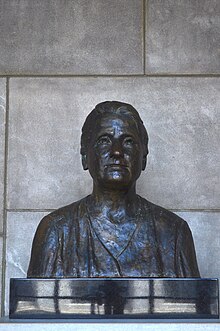Grace Abbott | |
|---|---|
 Grace Abbott in 1929 | |
| Born | November 17, 1878 |
| Died | June 19, 1939 (aged 60) |
| Occupation | Social worker |
| Parent(s) | Othman A. Abbott and Elizabeth M. Griffin |

Grace Abbott (November 17, 1878 [1] – June 19, 1939) was an American social worker who specifically worked in improving the rights of immigrants and advancing child welfare, especially the regulation of child labor. [2] Her elder sister, Edith Abbott, who was a social worker, educator, and researcher, had professional interests that often complemented Grace's.
Biography
Born in Grand Island, Nebraska, the daughter of O. A. Abbott and Elizabeth M. Griffin, [3] Grace graduated from Grand Island College in 1898. Before embarking on her career in social work, she was employed as a high school teacher in her hometown through 1906. In 1903, she started graduate studies at the University of Nebraska-Lincoln.
In 1907, she moved to Chicago, where she entered the career of social work. She took up residency in the Hull House, [2] an urban center for women engaged in early proto- feminism and social reform, as well as a safe haven for the poor. In 1909, Abbott received a Ph.M. in political science from the University of Chicago. She wrote a series of weekly articles in the Chicago Evening Post, titled Within the City's Gates from 1909 to 1910, which brought to light the exploitation of immigrants. [2]
Abbott served on several committees and organizations for advancing the societal cause of child welfare, including the Immigrants' Protective League (1908-1917), [2] Child Labor Division of the U.S. Children's Bureau (1921 to 1934), and was also a member of the Women's Trade Union League. In 1911, she co-founded the Joint Committee for Vocational Training with Sophonisba Breckenridge, PhD, JD, and Edith Abbott, PhD, JD.
From 1917 to 1919, she was the director of the child labor division of the U.S. Children's Bureau. It was in this capacity that she was responsible for administering the Keating-Owen Act (1916). This law was reversed by the U.S. Supreme Court in 1918. She was responsible for portions of this law continuing by inserting clauses into the war-goods contracts between the federal government and private industries. [2]
In 1924, she worked tirelessly to pass a constitutional amendment against child labor, an amendment that never gained statewide ratification. [2] Abbott was an author of several sociological texts, including The Immigrant and the Community (1917) [2] and The Child and the State (1938, 2 volumes). [2] She was also responsible for incorporating social statistics and research into legislative policy-making, as well as investigating child labor violations in shipbuilding plants and in factories across the United States.
Abbott pioneered the process of incorporating sociological data relating to child labor, juvenile delinquency, dependency, and statistics into the lawmaking process; she spent much of her time as a political lobbyist for social issues in Washington, D.C. She was associated with the Social Security Administration from 1934 until her death in 1939; during that time period, Abbott helped draft the Social Security Act and chaired several government committees on child welfare and social issues. [4]
She was the first woman to be nominated for a Presidential cabinet position, but was not confirmed. Her mother was a Quaker turned Unitarian and her father, Othman A. Abbott, was the first Lt. Gov. of the state of Nebraska. Grace never married. She was a professor of public welfare at the University of Chicago from 1934 until 1939. [2]
During a 1938 health checkup, doctors discovered that she was suffering from multiple myeloma. The disease caused her death one year later. Cancer was considered such a dreaded disease at the time that she and her sister hid her diagnosis and her obituary in The New York Times listed her cause of death as " anemia". [5]
Abbott is a member of the Nebraska Hall of Fame, [6] inducted in 1976.
The School of Social Work at the University of Nebraska at Omaha is named in her honor. [7]
References
- ^ "Abbott, Grace". Who Was Who Among North American Authors, 1921-1939. Detroit: Gale Research Co. 1976. pp. 2–3. ISBN 0810310414.
- ^ a b c d e f g h i "Abbott, Grace". Encyclopædia Britannica. Vol. I: A-Ak - Bayes (15th ed.). Chicago, Illinois: Encyclopædia Britannica, Inc. 2010. pp. 13. ISBN 978-1-59339-837-8.
- ^ Leonard, John William, ed. (1914), Woman's Who's Who of America: A Biographical Dictionary of Contemporary Women of the United States and Canada, 1914-1915, New York: American Commonwealth Company, p. 34.
- ^ "No Small Courage - A History of Women in the United States", Nancy F. Cott
- ^ Costin, Lela B. (2003). Two Sisters for Social Justice: A Biography of Grace and Edith Abbott. University of Illinois Press. pp. 233–235. ISBN 9780252071553.
- ^ "Nebraska Hall of Fame". History Nebraska. Archived from the original on October 5, 2019. Retrieved November 14, 2019.
- ^ "Grace Abbott School of Social Work". University of Nebraska Omaha. Retrieved November 14, 2019.
Further reading
- Longo, Julie; VanBurkleo, Sandra F. (February 2000). Abbott, Grace (1878-1939), social worker and administrator. American National Biography. doi: 10.1093/anb/9780198606697.article.1500002. ISBN 978-0-19-860669-7.
External links
-
 Media related to
Grace Abbott at Wikimedia Commons
Media related to
Grace Abbott at Wikimedia Commons - Abbott, Grace (1917) The Immigrant and the Community on Google Books
- Edith and Grace Abbott, Papers at the University of Nebraska-Lincoln
- Abbott Family papers [usurped] at Nebraska State Historical Society
- Grace Abbott Reader edited by John Sorensen with Judith Sealander (University of Nebraska Press, 2008)
- The Abbott Sisters Living Legacy Project at the Grace Abbott School of Social Work
- Edith and Grace Abbott Papers at the University of Chicago Special Collections Research Center